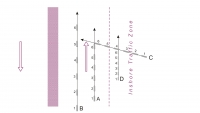-
Description of scenario:
Vessel A: Power-driven vessel
Vessel B: Power-driven vessel
Vessel C: Power-driven vessel
Area: Coastal waters
Visibility: Good (vessels are partly obscured in early stage of the scenario by headland, but when coming closer all vessels are in sight of one another)
Vessel A and vessel B are sailing in approximately parallel courses and vessel A is overtaking vessel B on her port side
Vessel A has vessel C on her own starboard side (relative bearing STBD 035°)
Vessel B has vessel C on her own starboard side (relative bearing STBD 045°)
Vessel A and vessel B are both in a crossing situation with vessel C so as to involve a risk of collision -
Rule(s) to be applied:
Rule 7 (Risk of collision)
Rule 13 (Overtaking)
Rule 15 (Crossing situation)
Rule 16 (Action by give-way vessel)
Rule 17 (Action by stand-on vessel) -
Applying the Rule(s) and comments:
Overtaking situation (vessel A and B):
In accordance with Rule 13 (a) (Overtaking situation), notwithstanding anything contained in the Rules of Part B, sections I and II, any vessel overtaking (vessel A) any other vessel (vessel B) shall keep out of the way of the vessel being overtaken (Vessel B).
In accordance with Rule 16 (Action by give-way vessel), every vessel (vessel A) which is directed to keep out of the way of another vessel (vessel B) shall, so far as possible, take early and substantial action to keep well clear.
In accordance with Rule 17 (a)(i) (Action by stand-on vessel), where one of two vessels is to keep out of the way (vessel A) the other (vessel B) shall keep her course and speed.
Crossing situation (vessel A and vessel C):
In accordance with Rule 7 (d)(i) (Risk of collision), a risk of collision shall be deemed to exist if the compass bearing of an approaching vessel does not appreciably change.
In accordance with Rule 15 (Crossing situation), when two power-driven vessels are crossing so as to involve risk of collision, the vessel (vessel A) which has the other (vessel C) on her own starboard side shall keep out of the way.
In accordance with Rule 15 (Crossing situation), vessel A shall, if the circumstances of the case admit, avoid crossing ahead of vessel C.
In accordance with Rule 16 (Action by give-way vessel), every vessel (vessel A) which is directed to keep out of the way of another vessel (vessel C) shall, so far as possible, take early and substantial action to keep well clear.
In accordance with Rule 17 (a)(i) (Action by stand-on vessel), where one of two vessels is to keep out of the way (vessel A) the other (vessel C) shall keep her course and speed.
In accordance with Rule 17 (a)(ii) (Action by stand-on vessel) the latter vessel (vessel C) may, however, take action to avoid collision by her manoeuvre alone, as soon as it becomes apparent to her that the vessel required to keep out of the way (vessel A) is not taking appropriate action in compliance with these Rules.
Crossing situation (vessel B and vessel C):
In accordance with Rule 15 (Crossing situation), when two power-driven vessels are crossing so as to involve risk of collision, the vessel (vessel B) which has the other (vessel C) on her own starboard side shall keep out of the way.
In accordance with Rule 15 (Crossing situation), vessel B shall, if the circumstances of the case admit, avoid crossing ahead of vessel C.
In accordance with Rule 16 (Action by give-way vessel), every vessel (vessel B) which is directed to keep out of the way of another vessel (vessel C) shall, so far as possible, take early and substantial action to keep well clear.
In accordance with Rule 17 (a)(i) (Action by stand-on vessel), where one of two vessels is to keep out of the way (vessel B) the other (vessel C) shall keep her course and speed.
In accordance with Rule 17 (a)(ii) (Action by stand-on vessel) the latter vessel (vessel C) may, however, take action to avoid collision by her manoeuvre alone, as soon as it becomes apparent to her that the vessel required to keep out of the way (vessel B) is not taking appropriate action in compliance with these Rules.
Comments:
In accordance with Rule 17 (a)(i) (Action by stand-on vessel), vessel C shall keep her course and speed for vessel A and vessel B.
In accordance with Rule 17 (a)(i) (Action by stand-on vessel), vessel B shall keep her course and speed for vessel A, but in accordance with Rule 15 (Crossing situation), vessel B shall keep out of the way for vessel C.
In accordance with Rule 13 (a) (Overtaking situation), vessel A shall keep out of the way of vessel B, but in accordance with Rule 15 (Crossing situation), vessel A shall keep out of the way for vessel C.
Vessels A, B and C shall sound warning signals in accordance with Rule 34 (e) (Manoeuvring and warning signals ) when nearing cape of the headland if other vessels may be obscured. In accordance with Rule 34 (e) (Manoeuvring and warning signals ), a vessel nearing a bend where other vessels may be obscured by an intervening obstruction shall sound one prolonged blast. Such signal shall be answered with a prolonged blast by any approaching vessel that may be within hearing around the bend or behind the intervening obstruction. -
Actions:
Vessel A and vessel B can take following actions to avoid collision or close-quarters situation.
If vessels A and B are not taking appropriate action, vessel C may also take some actions in accordance with Rule 17 (a)(ii) (Action by stand-on vessel).
- Graphics:

a) Vessel A may reduce speed at her earliest opportunity to avoid collision with vessel C (when she gains sight of vessel C and determines that the risk of collision exists)
Register to get free access to bird's-eye view video (and ECDIS view video)!
- Graphics:

b) Vessel A may make 360° turn to port to avoid collision with vessel C (when she gains sight of vessel C and determines that the risk of collision exists)
Register to get free access to bird's-eye view video (and ECDIS view video)!
- Graphics:

c) Vessel B may reduce speed at her earliest opportunity to avoid collision with vessel C (when she gains sight of vessel C and determines that the risk of collision exists)
Register to get free access to bird's-eye view video (and ECDIS view video)!
- Graphics:

d) Vessel C may reduce speed (when she gains sight of vessel A and B and determines that the risk of collision exists), as soon as it becomes apparent to her (vessel C) that the vessels required to keep out of the way (vessels A and B) are not taking appropriate action in compliance with these Rules
Register to get free access to bird's-eye view video (and ECDIS view video)!
- Graphics:

e) Vessel C may make 360° turn to starboard (when she gains sight of vessel A and B and determines that the risk of collision exists), as soon as it becomes apparent to her (vessel C) that the vessels required to keep out of the way (vessels A and B) are not taking appropriate action in compliance with these Rules
Register to get free access to bird's-eye view video (and ECDIS view video)!
Scenarios
Basic COLREGs Course - Visit our basic course for single rule scenarios and interpretation!
This project has been funded with support from the European Commission. This publication [communication] reflects the views only of the author, and the Commission cannot be held responsible for any use which may be made of the information contained therein.



























